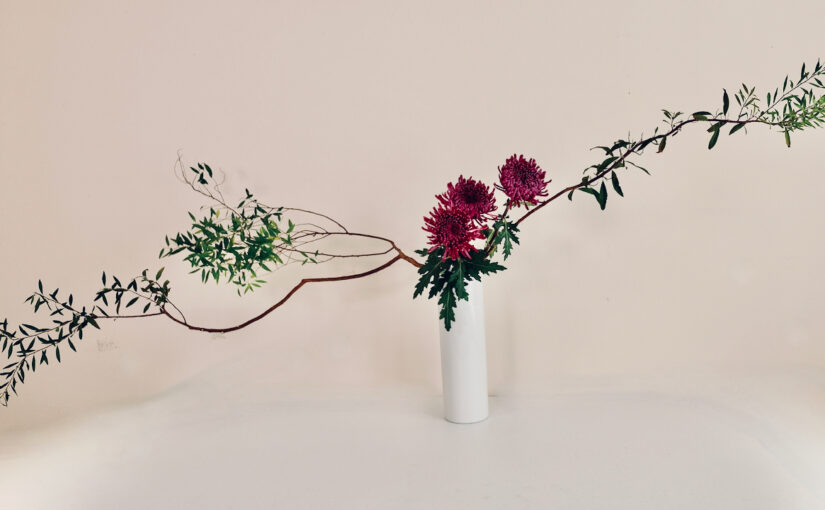Don’t forget line, mass, and color!
Photo by Author Akemi Sagawa
Beautiful flowers do not always make beautiful ikebana (Japanese flower arrangement).
Sofu Teshigahara
When creating an Ikebana arrangement, there are three basic elements that you want to keep in mind: Line, Mass, and Color.
Line
Straight, curved, twirling… Nature provides tree branches and flower stems with countless different shapes of lines. For Ikebana, you want to make the best use of these interesting lines in your arrangement.
If you place the line upright, you are creating something vertical in shape. Place it sideways, your ikebana spreads horizontally.
Looking at how the leaves and flowers are growing on the branch, you can see from which direction it was enjoying the sunlight for its growth. The side where the sunlight was shining on the leaves, we recognize it as the front of the branch. Also, you can tell from which side to which side the branch was growing.
Place the branch with the tip on top, you can feel the energy going up. Place it with the tip down, the energy flow seems downward.
Facing all the front leaves towards you, then the branch is facing you. Turn around, and if you see only the back of the leaves, then the branch is showing you its back.
With only one branch, you can express so many things; direction, energy flow, and movement (up or down?). That’s because the branch has a life!
Use two branches. However you place these two branches, the space between the two becomes the surface. Remember the geometry class in high school?
With the third branch, you add depth to your Ikebana. It’s like sculpture. Your canvas is the three-dimensional space in front of you.
Lines determine the basic structure of your Ikebana arrangement.
Mass
When you take a look at one branch, you notice that there are abundant leaves in some parts, and you see barely any leaves in other parts. Similarly, there are some flowers that have massive volumes of flowers like hydrangea, and others that have sparse flowers here and there, like cherry blossoms.
The massive volume gives you a strong impression, and sparsity gives you a gentle impression.
When creating an Ikebana arrangement, you want to utilize this variety of mass (or volume) and sparsity (lack of mass or volume) to make it interesting.
Place some volume in one part and add some sparsity on the other. Then you are adding a rhythm to your arrangement. Yes, Ikebana can be similar to music!
Color
Can you imagine how boring it would be if nature came with only black and white? Thankfully, there are flowers in every single color you can imagine. Leaves have countless shades of green!
You want to make best use of the colors that nature provides you in your Ikebana arrangement.
Place vivid red color flowers right next to the deep, shiny green leaves if you want to make a strong statement. The high color contrast combination is effective.
If you want to give a harmonious, gentle, and soft impression on your arrangement, use similar, pastel colors.
Line, Mass, and Color… The fun part of learning Ikebana is how you can improve by utilizing three elements. I hope you will keep these three elements next time you make an arrangement!
